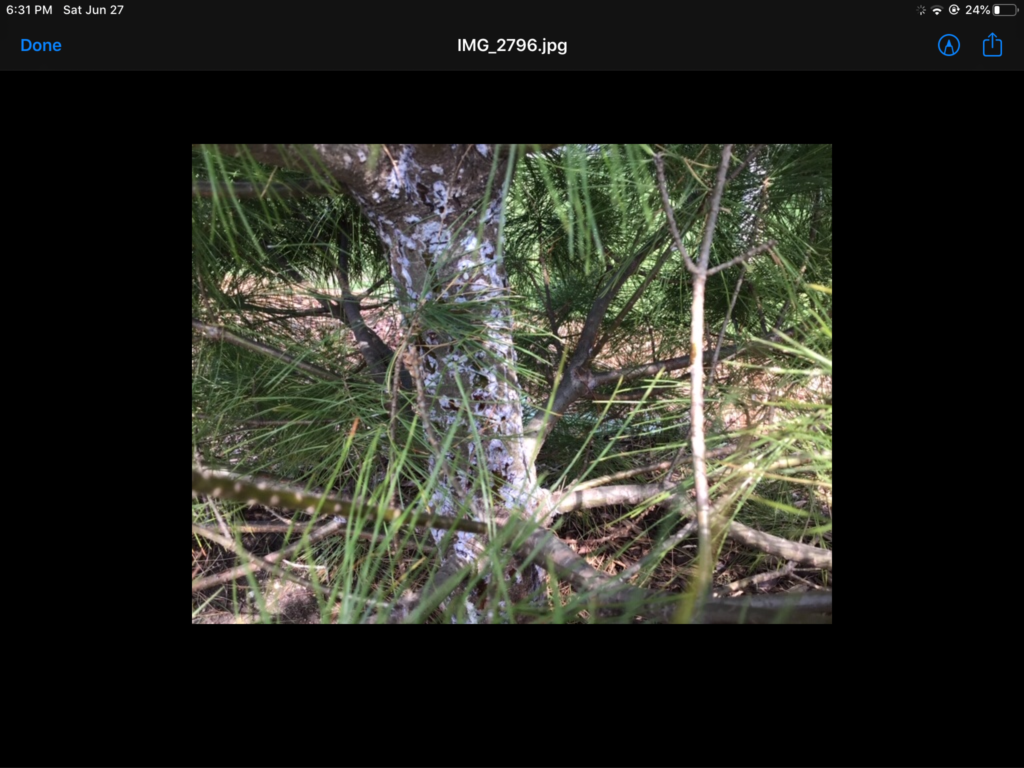
Hello, I had 6 white pine trees planted last fall. In my attempts to deal with the Gypsy moth infestation I had run out of insecticide and was hand removing the caterpillars from my trees. When I got to the white pine trees, I noticed this white oozing sap on the trunk of 4 of the 6 trees planted last fall. My question is this a fungus, possibly white pine blister rust or a pine borer? The trees are approximately 6 feet tall, they all have new green growth and from a distance do not look diseased at all. A close up view does show extensive green pine needles on The ground. This white substance oozing from the trunk of the treeS was only noticed after a close inspection looking for caterpillars.
My second question is, whatever this may be, Is it possible that the disease was already on the tree before I got them? I purchased from a grower and I am now wondering if the trees had this disease prior to my delivery and It wasn’t evident until this spring. Had I seen this earlier I could have sprayed them with an insecticide. Now I feel it may be too late in the season to spray. Your help is greatly appreciated
I am so sorry to hear about your sad white pines! Unfortunately your photo does not show anything other than a distant view of whitish bark. Below I provide information on the fungus and insect you feel might be affecting your trees, but please bear in mind that there could be other causes of the symptoms.
White pine blister rust (WPBR) is a fungus whose symptoms include oozing sap that can be white – the sap would ooze from a canker that is usually oval or diamond in shape. Here are a couple of helpful websites that include both lots of clear photos of WPBR-infected trees and what to do if the trees are infected:
- University of Minnesota Extension. White pine blister rust.
- Penn State Extension. White pine blister rust.
Note that it is often hard to detect the subtle symptoms of WPBR in the first year a tree is infected, but starting the second year, cankers will be evident on branches and the trunk. Also, as the rust needs 2 hosts to complete its life cycle – both a white pine and plants in the genus Ribes (e.g., currant or gooseberry bush) – check for these bushes on or near your property and remove them if they are infected.
Some good news: there are WPBR-resistant varieties of pines and currants/gooseberries.
From your description, this does not sound like a pine borer, although this insect too could cause sap to flow from the trees and the needles would turn yellow or brown. However, there would likely also be little tunnels under the bark as well as droppings that look like sawdust at the base of the tree. See SF Gate’s Boring beetles.
Consider also whether you have taken good care of the trees – were they properly spaced apart when planted? They prefer full sun, but tolerate partial shade – were they sited properly? Were they planted in good soil that drains well? Do they need fertilizer? Is the area around the trees kept relatively free of debris (where pests could thrive)? Were they watered deeply in order to establish themselves and/or during periods of dry weather?
As for your second question, it is possible that the trees harboured some sort of disease/pest when you purchased them – the 2 trees that now seem healthy could also be afflicted, we just don’t know. We can’t be sure that this is WPBR at this point – so I’d suggest that you return to the nursery where you purchased the trees and ask them to help identify the problem. As well, you may want to ask to return the trees and request new ones – a reputable nursery should offer at least a year’s warranty on their trees.
Finally, you may wish to search the Landscape Ontario website to find an arborist in your area, who may be able to help diagnose the problem and provide further direction.
All the best with your trees!

